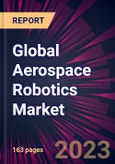1h Free Analyst Time
The aerospace robotics market is forecasted to grow by USD 1,587.85 mn during 2022-2027, accelerating at a CAGR of 9.2% during the forecast period. The report on the aerospace robotics market provides a holistic analysis, market size and forecast, trends, growth drivers, and challenges, as well as vendor analysis covering around 25 vendors.Speak directly to the analyst to clarify any post sales queries you may have.
The report offers an up-to-date analysis regarding the current market scenario, the latest trends and drivers, and the overall market environment. The market is driven by high efficiency and productivity of robots, high growth of aerospace industry, and increased automation in aerospace industry.
The aerospace robotics market is segmented as below:
By Type
- Traditional robots
- Collaborative robots
By Component
- Controller
- Arm processor
- Sensors
- Drive
- End effectors
By Geographical Landscape
- North America
- Europe
- APAC
- Middle East and Africa
- South America
The report on the aerospace robotics market covers the following areas:
- Aerospace robotics market sizing
- Aerospace robotics market forecast
- Aerospace robotics market industry analysis
The study was conducted using an objective combination of primary and secondary information including inputs from key participants in the industry. The report contains a comprehensive market and vendor landscape in addition to an analysis of the key vendors.
The publisher presents a detailed picture of the market by the way of study, synthesis, and summation of data from multiple sources by an analysis of key parameters such as profit, pricing, competition, and promotions. It presents various market facets by identifying the key industry influencers. The data presented is comprehensive, reliable, and a result of extensive research - both primary and secondary. The market research reports provide a complete competitive landscape and an in-depth vendor selection methodology and analysis using qualitative and quantitative research to forecast the accurate market growth.
Table of Contents
PART 01: EXECUTIVE SUMMARYPART 02: SCOPE OF THE REPORTPART 03: RESEARCH METHODOLOGYPART 09: CUSTOMER LANDSCAPEPART 11: DECISION FRAMEWORK
PART 04: MARKET LANDSCAPE
PART 05: MARKET SIZING
PART 06: FIVE FORCES ANALYSIS
PART 07: MARKET SEGMENTATION BY APPLICATION
PART 08: MARKET SEGMENTATION BY SOLUTION
PART 10: REGIONAL LANDSCAPE
PART 12: DRIVERS AND CHALLENGES
PART 13: MARKET TRENDS
PART 14: VENDOR LANDSCAPE
PART 15: VENDOR ANALYSIS
PART 16: APPENDIX
List of Exhibits
Executive Summary
The publisher recognizes the following companies as the key players in the global aerospace robotics market: ABB Ltd., Electroimpact Inc., Festo SE and Co. KG, General Electric Co., Hyundai Motor Co., Intel Corp., JH Robotics Inc, Kawasaki Heavy Industries Ltd., NACHI FUJIKOSHI Corp., OMRON Corp., Sarcos Technology and Robotics Corp., Staubli International AG, Stellantis NV, Tata Motors Ltd., Teradyne Inc., Yaskawa Electric Corp., MIDEA Group, Seiko Epson Corp., AV and R Vision and Robotics Inc., and FANUC Corp..Commenting on the report, an analyst from the research team said: 'The latest trend gaining momentum in the market is industry 4.0 and digital transformation in aerospace industry.'
According to the report, one of the major drivers for this market is the high efficiency and productivity of robots.
The study was conducted using an objective combination of primary and secondary information including inputs from key participants in the industry. The report contains a comprehensive market and vendor landscape in addition to a SWOT analysis of the key vendors.
Companies Mentioned (Partial List)
A selection of companies mentioned in this report includes, but is not limited to:
- ABB Ltd.
- Electroimpact Inc.
- Festo SE and Co. KG
- General Electric Co.
- Hyundai Motor Co.
- Intel Corp.
- JH Robotics Inc
- Kawasaki Heavy Industries Ltd.
- NACHI FUJIKOSHI Corp.
- OMRON Corp.
- Sarcos Technology and Robotics Corp.
- Staubli International AG
- Stellantis NV
- Tata Motors Ltd.
- Teradyne Inc.
- Yaskawa Electric Corp.
- MIDEA Group
- Seiko Epson Corp.
- AV and R Vision and Robotics Inc.
- FANUC Corp.








